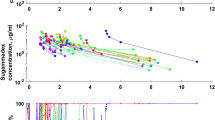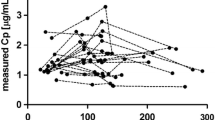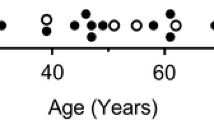Summary
Introduction
Bayesian forecasting has been shown to improve the accuracy of pharmacokinetic/pharmacodynamic (PK/PD) models by adding measured values to a population model. It could be done in real time for neuromuscular blockers (NMB) using measured values of effect. This study was designed to assess feasibility and benefit of Bayesian forecasting during a rocuronium target-controlled infusion (TCI).
Methods
After internal review board (IRB) approval and informed consent, 21 women scheduled for breast plastic surgery were included. Anesthesia was maintained with propofol, alfentanil, and controlled ventilation through a laryngeal mask. Rocuronium was delivered in TCI with Stanpump software and the Plaud population model. The target effect was 50% blockade until insertion of breast prosthesis; thereafter it was set to 0%. Response to train of four (TOF) at adductor pollicis was recorded using a force transducer. In ten patients, drug delivery was based on the population model. In the others, repeated measures values were entered in the software, and the PK model was adjusted to minimize the error in predicted effect. Model precision was compared between groups using mean prediction error and mean absolute prediction error.
Results
At target 50%, model accuracy was not improved with Bayesian adjustments; conversely, post-infusion errors were significantly decreased. The first two measures had the most influence on the model changes.
Discussion
Below clinical utility, such adjustments may be used to explore cofactors influencing interindividual and intraindividual variability in NMB dose-response relationship. Similar tools may also be developed for drugs in which a quantitative effect is available, such as electroencephalography (EEG) for hypnotics.
Implication
Real-time Bayesian forecasting combining measured values of effect with a population model is suitable to guide NMB-agent delivery using Stanpump software.


Similar content being viewed by others
References
Dahaba AA, Rehak PH et al (1996) A comparison of mivacurium infusion requirements between young and elderly adult patients. Eur J Anaesthesiol 13(1):43–48
Donati F (2000) Cumulation and flexibility with infusions of neuromuscular blocking drugs. Can J Anaesth 47(10):936–942
Ebeling BJ, Muller W et al (1991) Adaptive feedback-controlled infusion versus repetitive injections of vecuronium in patients during isoflurane anesthesia. J Clin Anesth 3(3):181–185
Egan TD (2003) Target-controlled drug delivery: progress toward an intravenous "vaporizer" and automated anesthetic administration. Anesthesiology 99(5):1214–1219
Eleveld DJ, Kuizenga K et al (2007) A temporary decrease in twitch response during reversal of rocuronium-induced muscle relaxation with a small dose of sugammadex. Anesth Analg 104(3):582–584
Fernandez-Candil J, Gambus PL et al (2008) Pharmacokinetic-pharmacodynamic modeling of the influence of chronic phenytoin therapy on the rocuronium bromide response in patients undergoing brain surgery. Eur J Clin Pharmacol 64(8):795–806
Fernandez de Gatta MM, Garcia MJ et al (1996) Bayesian forecasting in paediatric populations. Clin Pharmacokinet 31(5):325–330
Fisher DM, Wright PM (1997) Are plasma concentration values necessary for pharmacodynamic modeling of muscle relaxants? Anesthesiology 86(3):567–575
Hu C, Horstman DJ et al (2005) Variability of target-controlled infusion is less than the variability after bolus injection. Anesthesiology 102(3):639–645
Jelliffe RW, Schumitzky A et al (1993) Individualizing drug dosage regimens: roles of population pharmacokinetic and dynamic models, Bayesian fitting, and adaptive control. Ther Drug Monit 15(5):380–393
Lugo G, Castaneda-Hernandez G (1997) Amikacin Bayesian forecasting in critically ill patients with sepsis and cirrhosis. Ther Drug Monit 19(3):271–276
Maitre PO, Buhrer M et al (1991) A three-step approach combining Bayesian regression and NONMEM population analysis: application to midazolam. J Pharmacokinet Biopharm 19(4):377–384
Maitre PO, Stanski DR (1988) Bayesian forecasting improves the prediction of intraoperative plasma concentrations of alfentanil. Anesthesiology 69(5):652–659
Naguib M (2007) Sugammadex: another milestone in clinical neuromuscular pharmacology. Anesth Analg 104(3):575–581
Plaud B, Proost JH et al (1995) Pharmacokinetics and pharmacodynamics of rocuronium at the vocal cords and the adductor pollicis in humans. Clin Pharmacol Ther 58(2):185–191
Rousseau A, Leger F et al (2004) Population pharmacokinetic modeling of oral cyclosporin using NONMEM: comparison of absorption pharmacokinetic models and design of a Bayesian estimator. Ther Drug Monit 26(1):23–30
Schumacher GE, Barr JT (1984) Bayesian approaches in pharmacokinetic decision making. Clin Pharm 3(5):525–530
Schwilden H, Schuttler J et al (1987) Closed-loop feedback control of methohexital anesthesia by quantitative EEG analysis in humans. Anesthesiology 67(3):341–347
Sheiner LB, Stanski DR et al (1979) Simultaneous modeling of pharmacokinetics and pharmacodynamics: application to d-tubocurarine. Clin Pharmacol Ther 25(3):358–371
Sparr HJ, Wierda JM et al (1997) Pharmacodynamics and pharmacokinetics of rocuronium in intensive care patients. Br J Anaesth 78(3):267–273
Struys MM, De Smet T et al (2001) Comparison of closed-loop controlled administration of propofol using Bispectral Index as the controlled variable versus "standard practice" controlled administration. Anesthesiology 95(1):6–17
Szenohradszky J, Fisher DM et al (1992) Pharmacokinetics of rocuronium bromide (ORG 9426) in patients with normal renal function or patients undergoing cadaver renal transplantation. Anesthesiology 77(5):899–904
Yang L, Wang HL et al (2012) Population pharmacokinetics of rocuronium delivered by target-controlled infusion in adult patients. Chin Med J (Engl) 123(18):2543–2547
Author information
Authors and Affiliations
Corresponding author
Additional information
This prospective study illustrates the influence of real-time Bayesian pharmacokinetic parameter adjustments on the precision of a rocuronium computer-controlled infusion.
Rights and permissions
About this article
Cite this article
Motamed, C., Devys, JM., Debaene, B. et al. Influence of real-time Bayesian forecasting of pharmacokinetic parameters on the precision of a rocuronium target-controlled infusion. Eur J Clin Pharmacol 68, 1025–1031 (2012). https://doi.org/10.1007/s00228-012-1236-3
Received:
Accepted:
Published:
Issue Date:
DOI: https://doi.org/10.1007/s00228-012-1236-3




